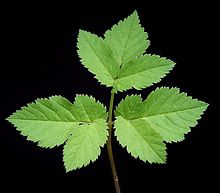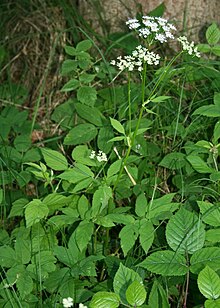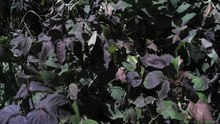Giersch
| Common groundgrass | ||||||||||||
|---|---|---|---|---|---|---|---|---|---|---|---|---|

Common groundgrass ( Aegopodium podagraria ) |
||||||||||||
| Systematics | ||||||||||||
|
||||||||||||
| Scientific name | ||||||||||||
| Aegopodium podagraria | ||||||||||||
| L. |
Common groundgrass ( Aegopodium podagraria ) is a species of the genus Aegopodium in the umbelliferae (Apiaceae) family. It is the only Aegopodium species found in Europe . The botanical genus name Aegopodium is derived from the Greek αἰγοπόδης aigopódēs , German ' goat- footed' (from αἴξ aix , German 'goat' , Gen. αἰγός aigós , and πούς pús , German 'foot' , Gen. ποδός podós. ), And refers to the shape of the leaves, reminiscent of a goat's foot. The specific epithet podagraria indicates that this plant species has been used in folk medicine for centuries to relieve pain in rheumatism and gout (podagra).
Giersch is considered an annoying weed by gardeners ; it grows rampant and is difficult to fight because of its underground instincts. On the other hand, ground elder is a tasty wild vegetable .
description
Vegetative characteristics
The ground elder grows as a perennial herbaceous plant and reaches heights of 30 to 100 centimeters. Since the ground elder emerges from a strongly overgrown rhizome , the runners can form colonies. The bare stem is characteristically angular and furrowed.
The alternate arranged on the stem leaves are divided into petiole and leaf blade. The leaf blade is double-triple or double-pinnate. The leaflets are oval-elongated and have a serrated edge. The first-order leaflets often have only two columns.
Generative characteristics
The double-gold inflorescence is flat and 12 to 25-rayed. Both bracts and bracts are missing . The inconspicuous, white flowers are hermaphroditic and five-fold. The flowering period usually extends from June to July.
The winged, caraway-like, two-part split fruit , also known as the double achane, is egg-shaped with a length of 3 to 4 millimeters.
The species has chromosome number 2n = 42, 44 or 22.
ecology
The ground elder is a hemicryptophyte . With underground runners , individual plants spread over large areas within a few years. Vegetative reproduction is predominant, it takes place through the wide and deep creeping, white, brittle, underground runners , which reach a minimum length of 20 cm and a diameter of 2 mm. It is rooted up to 50 centimeters deep.
The leaves close to the ground survive in mild winters; the ground elder is thus partly winter green. In terms of flower ecology, it is “nectar-bearing disc flowers of the Heracleum type”. Special mechanisms of propagation are not known; but it is spreading unintentionally by humans.
The Giersch is the rust fungus Puccinia aegopodii with Telien affected. The fungus Protomyces macrosporus produces galls on leaf stalks and nerves. The leaf flea Trioza flavipennis also causes plant gall .
Occurrence
The ground elder is widespread in almost all of Europe and the temperate continental areas of the Eurasian deciduous forest belt. Its distribution area includes Europe, Turkey, the Caucasus, Kazakhstan, Kyrgyzstan and Siberia. It was introduced into North America. It loves nitrogen-rich soils and is common in gardens, shady, moist bushes and forests. It thrives on absolutely fresh or seeping fresh, nutrient-rich and alkaline-rich, loose, deep, mild to moderately acidic, humus-rich clay and loam soils. It is a weak character species of the Urtico-Aegopodietum, but also occurs in Central Europe in societies of the Convolvulion, Alno-Ulmion or humid Querco-Fagetea.
It rises in the Allgäu Alps in the Tyrolean part in the Höhenbachtal near the Vorderen Schochenalpe up to 1360 m above sea level.
use
In the Middle Ages, but also in more recent times, ground elder was grown both as a vegetable and as a medicinal plant.
Traditional medicinal plant
The common name Podagrakraut or Zipperleinskraut indicates that ground grass was used as a remedy for gout . It is also said to have an antispasmodic, detoxifying and blood purifying effect against rheumatism and arthritis. Since no evidence for the indicated indications was found, the ground elder is no longer listed in new pharmacopoeias.
nutrition
When raw, the smell and taste of Giersch is reminiscent of parsley mixed with the resinous aroma of a mango, while cooked it is reminiscent of spinach . Since ground, unlike most vegetables, is available for many months and has low demands on soil, water and light supply, it ensured that many people received vitamins during the world wars, for example.
The young, green leaves contain (100 g each) about: 200 mg vitamin C , 5 mg carotene , 130 mg calcium , 5 mg magnesium , 3 mg iron and 2 mg copper .
Giersch can be prepared as a salad or vegetable . The young, barely unfolded leaves are particularly suitable as a salad. Raw leaves can also be added to spreads and soups. After flowering, the taste becomes stronger and a slight laxative effect can occur. Removing the flowers can partially prevent this. Older leaves are suitable as tea or for cooking or stewing. The bitter stems are tough and should be removed.
When collecting, avoid confusion with inedible and poisonous species, such as spotted hemlock or broad-leaved Merkel . Giersch can be recognized by the triangular leaf stalk, with one edge rounded and the opposite side concave.
Guinea pigs and rabbits like to eat the groundfish.
Combat
"In the fight against the ground elder shows the futility of human activity." Even if the roots are chopped, the plant usually regenerates quickly. Conventional herbicides approved for home and allotment gardens are largely ineffective against ground elder, as they do not destroy the entire root system. Also glyphosate destroyed Giersch not complete. After about two years of coverage, the plants will die - but not the seeds. Giersch can be weakened by regular removal of the leaves for years until it dies. Potatoes can suppress the ground elder because they grow faster and take away light and nutrients.
On the market are growth regulators based on maleic acid hydrazide and pelargonic acid , which are offered specifically for combating yawl.
Common names
Trivial names for the Giersch are three-leaf , goat's foot , horny goat weed , Schettele , Zaungiersch , Baumtropf . Because the leaves resemble the Hollerbusch (elder) , it is also called Wiesenholler . Regionally, the following names are used: Ackerholler ( Carinthia ), Erdholler or Wilder Holler ( Styria , North Baden ), Angelken (North dithmarschen ), Bomkraut (high German Baumkraut; from the strong roots), Upper Swabian Alb , Baumtropfe ( Aargau , Bern , Zurich ), Baumtröpfli (Aargau, Bern, Zurich), Cheeßeln [( ch as in me ) Uslar , Ostfalen], Dreifuss ( Daun , Eifel ), Small wild angelica, Fearkenfaite (meaning " piglet feet ") ( Iserlohn ), Gäse ( county Mark ), Gese (Grafschaft Mark), Garta (Iborig, St. Gallen ), Geersch ( Pomerania ), Geerseln ( Unterweser ), Geesche ( Braunschweig ), Geesel (Unterweser), Geeske ( East Friesland ), Geesekohl ( Hümmling ), Geisfüssel, Geisfuss, Gere (Berg), Gerhardskraut, Gerisch ( Mark Brandenburg ), Gersse, Gerzel ( Altmark ), Gesch ( Mecklenburg ), Geseln ( Göttingen ), Gezeln (Göttingen), Geszenkielm (Marsburg), Gierisch ( Silesia ), Giers (Mecklenburg ), Gierts (Mecklenburg), Giersa, Gierschke, Giersick , Giersig (Silesia), Giesseln (Lower Weser), Girsch (Ulm), Girschke, Gösch ( Lübeck , Mecklenburg), Griessbart (Silesia), Gurisch ( Leipzig ), Gysch, Härsch (East Frisia), Hasenschätteln ( Memmingen ), Hasenscherteln ( Augsburg ), Heerke (Unterweser), Heersch (Dithmarschen, Oldenburg), Herske (East Friesland), Hinfuss (Ulm), Hinlauf, Hirs (Mecklenburg), Jesche ( Fallersleben ), Jessel, Jorisquek ( Hamburg ), Jörsquek ( Holstein ), Jörs ( Holstein, Lübeck), Jösk (Mecklenburg), Jürs (Mecklenburg), rabbit or rabbit food (Erfurt area), Krafues (Carinthia), Krahhaxen (Styria), Maienkraut (Bern), Negenstark, Nebensterke, Podagramskraut, Rutzitzke ( Niederlausitz ), Schnäggachrut (St. Gallen), Strenzel, Wasserkraut (Carinthia), Wetscherlewetsch, Witscherlenwertsch (Ulm), Wuchchrut ( Appenzell , Upper Rhine Valley), Wild Angelika ( Ulm ), Horny Goat Weed (Leipzig), Zipperleinskraut, Zipperlikraut (Bern).
Trivia
The poet and Leipzig Book Prize winner in 2015 Jan Wagner dedicated a poem to the groundwater in the rain barrel variations .
literature
- Heinz Ellenberg : Vegetation of Central Europe and the Alps , UTB, Stuttgart 2010, ISBN 3-8001-3430-6
- Manfred A. Fischer, Karl Oswald, Wolfgang Adler: Excursion flora for Austria, Liechtenstein and South Tyrol . 3rd, improved edition. State of Upper Austria, Biology Center of the Upper Austrian State Museums, Linz 2008, ISBN 978-3-85474-187-9 .
- Elisabeth Mayer: wild fruits, wild vegetables, wild herbs . Stocker, 2001, ISBN 3-7020-0835-7 , pages 38-40.
- Giersch. In: FloraWeb.de. (Section description)
- Eckehart J. Jäger (Ed.): Rothmaler excursion flora of Germany . Springer Spectrum, 21st edition, 2016, ISBN 978-3662497074 .
Individual evidence
- ↑ a b c d Giersch. In: FloraWeb.de.
- ↑ a b c d Erich Oberdorfer : Plant-sociological excursion flora for Germany and neighboring areas . 8th edition. Stuttgart, Verlag Eugen Ulmer, 2001. Pages 711-712. ISBN 3-8001-3131-5
- ↑ a b c d Ruprecht Düll , Herfried Kutzelnigg : Pocket dictionary of plants in Germany and neighboring countries. The most common Central European species in portrait . 7th, corrected and enlarged edition. Quelle & Meyer, Wiebelsheim 2011, ISBN 978-3-494-01424-1 .
- ↑ Peter Zwetko: The rust mushrooms Austria. Supplement and host-parasite directory to the 2nd edition of the Catalogus Florae Austriae, III. Part, Book 1, Uredinales. (PDF; 1.8 MB).
- ↑ Hermann Roß: Practical course in gallology "Cecidology". Springer-Verlag, 2013 - 314 pages; Page 29. Online
- ↑ Trioza flavipennis on Psyl'list , accessed January 29, 2015.
- ^ Aegopodium in the Germplasm Resources Information Network (GRIN), USDA , ARS , National Genetic Resources Program. National Germplasm Resources Laboratory, Beltsville, Maryland. Retrieved May 8, 2018.
- ↑ Erhard Dörr, Wolfgang Lippert : Flora of the Allgäu and its surroundings. Volume 2, IHW, Eching 2004, ISBN 3-930167-61-1 , p. 274.
- ^ Ingrid and Peter Schönfelder : The new handbook of medicinal plants , Franckh-Kosmos Verlagsgesellschaft, 2011, ISBN 3-440-09387-5
- ↑ Waldemar Ternes , Alfred Täufel, Lieselotte Tunger, Martin Zobel (eds.): Food Lexicon . 4th, comprehensively revised edition. Behr, Hamburg 2005, ISBN 3-89947-165-2 , pp. 701 ( limited preview in Google Book search).
- ↑ Susanne Wiborg: Weeds win. Die Zeit , June 9, 2005, accessed on July 4, 2015 .
- ^ Folkert Siemens: Fighting Giersch successfully. In: My beautiful garden. Burda Senator Verlag GmbH, April 8, 2009, accessed April 18, 2013 .
- ↑ Finalsan® GierschFree concentrate. (No longer available online.) In: neudorff.de. Archived from the original on June 17, 2015 ; Retrieved June 4, 2015 . Info: The archive link was inserted automatically and has not yet been checked. Please check the original and archive link according to the instructions and then remove this notice.
- ↑ Plant protection agent active ingredient maleic acid hydrazide. In: proplanta.de. Retrieved June 4, 2015 .
- ^ Carl Jessen : The German folk names of plants , published by Philipp Cohen Hanover 1882, page 11 f.
- ↑ Jan Wagner reads Giersch . Kulturzeitvideo on zdf.de , October 27, 2017, (available until October 27, 2022).
Web links
- Giersch. In: FloraWeb.de.
- Profile and distribution map for Bavaria . In: Botanical Information Hub of Bavaria .
- Giersch . In: BiolFlor, the database of biological-ecological characteristics of the flora of Germany.
- Aegopodium podagraria L. In: Info Flora , the national data and information center for Swiss flora .
- Distribution in the Netherlands [1] (Dutch)
- Photos of the Zaun-Giersch or Gout-Giersch.
- Map for worldwide distribution according to Eric Hultén







